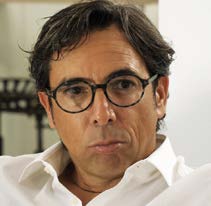A cultural mediator, an ideal go-between between production-oriented, Chinese OEM tradition and customer-centric home appliance multinationals, Federico Rebaudo brought global thinking into Homa’s strategy: deciphering Western cultural business codes on one hand, bringing the Chinese industrial genius, technology and might to the world’s premier league manufacturers and private labels on the other hand.
Rebaudo likes to compare Homa, and himself, to an olive tree, with branches reaching out to the world but with roots solidly implanted in one place. A recurrent figure in the literature of all times, the olive tree is a symbol of wisdom and humility, of longevity and vitality. Rebaudo’s own roots, situated in Bordighera, a mediterranean coastal town on the French Italian border, tell about a territory that is hard to tame, where the olive trees themselves belong to a different breed from the ones you can find in other olive producing regions, for they need to be stronger to survive the harsh, unforgiving conditions of this frontier land. This reflects in the character of the natives, who don’t take anything for granted and are ready to wrestle success out of any unfavourable situation. It’s also a land of travellers, navigators and pioneers, and Federico Rebaudo took after this tradition when he decided to leave the comfort and security of his job with a prime Italian appliance brand and take a leap of faith by joining a small, almost unknown at the time, Chinese OEM.
Some 11 years on, Homa is a multinational corporation and the world’s leading exporter of refrigerators, with Rebaudo heading its European business.

Born 50 years ago in Bordighera, where the Alps dive into the Mediterranean Sea on the border with France, Federico Rebaudo studied Management and Economics across Europe. He started an career in marketing in Paris, and later moved back to Italy where, after holding positions of increasing responsibility, he became Group Marketing Director, Cooling Products, at Candy. 11 years ago he decided to take up a new, global challenge, and joined Homa. As General Manager he founded, organised and led Homa’s European Office, which he is currently heading. Passionate about market and product strategy, with a particular taste for design, he inspires and develops unique communication projects for Homa’s international markets
Tell us about your first encounter with Homa
At the time, I was the Global Marketing director of the cooling division of one of Italy’s leading home appliance manufacturers. They were among the first to consider sourcing not as a tactical move but as a strategic opportunity. I set out to find partners that could see the potential in moving away from a cherry-picking, off-the-shelf mentality, and engage in producing actual ranges of products, or parts of, with us. I was seeking a real, strategic partnership, not someone who could mass produce white boxes inexpensively, but someone who could produce those white boxes in a very qualitative yet still highly competitive way and re-interpret them to the liking of those who in turn would put their own labels on them and market them under their own brands.At one point I came across this small factory, in China, where I met people with whom I felt immediately at ease. Michael Yao was among them. Over a couple of meetings we realised we perfectly understood each other. I knew I had found the partners I needed, yet Homa wasn’t as technologically advanced as other OEMs and was mostly making small, very simple products. This was vastly outweighed by their open-minded attitude, their willingness to listen and their capacity to recognise an opportunity. They were also keen to bring disruptive innovation to the classic client-supplier relationship, which we were later to turn into a successful business model.
Homa’s strength derives from their being different, for beyond their industrial firepower they have given a new interpretation to the concept of OEM. I had perceived it first as a client, then as part of the Homa organisation, and kept nurturing that unique attitude.
The majority of those shopping for products in China at the time were procurement people, they just wanted the best deal. I was looking for an industrial partner who would not simply sell me a fridge, but help me manufacture entire ranges.

How did that turn out?
17 years ago, my Italian company simply did not possess the industrial might to invest in all product categories, and needed to protect its leadership in the washing category while investing into the built-in market to fend-off aggressive newcomers and maintain high margins. Moreover, the group did not have such a great legacy in cooling. As the head of the cooling division’s marketing, I was in trouble, since I had no internal funds to come up with an attractive and competitive new range of products. But problems often come with opportunities. Strategic sourcing stood out as the best possible course to take, yet I needed to find more of an industrial partner than a classic OEM. Nobody saw sourcing in this way, at the time.
I had the opportunity to express new ideas and help Homa influence the entire industry.
Eventually procurement signed off the deal, although they doubted this small player could really help us, and we started the adventure. We had our first products designed by a young Sicilian designer, Umberto Palermo, whom we gave the specific brief to come up with a product that any factory would be able to produce, be it in Turkey, the Czech Republic or China, and whatever its technology level. To avoid using moulds, which normally require advanced industrial skills, we found a workable and quite satisfactory solution involving a more reliable drawing process. It worked out quite well, beyond our expectations.
Being a major player on the world scene requires sensitivity, the sensitivity to understand that one’s product is much more than a simple appliance.
How did you come to join Homa?
After that initial contact and successful collaboration.The company went on growing, and at one point Michael Yao reached out and offered me to join them. They wanted me on board to help them create product ranges that not only would satisfy global clients’ requests, but anticipate their needs and that of consumers worldwide.This was an opportunity for me to express new ideas and contribute to Homa’s capacity to influence the entire industry. Moreover, I found Homa’s company culture strongly supportive of real innovation, which isn’t simply technological but is more a question of cultural approach to a certain product category. Homa just turned 20, and the for the past 10 to 15 years it’s been truly driving innovation. Through its concept of pop-exclusivity, it made some cutting-edge products accessible to a larger group of its client-companies’ final consumers. Thanks to its sheer industrial scale, with a production capacity of 12 to 13 million units a year, Homa made these new product platforms, featuring the latest and more meaningful technology in food preservation, available to a much wider audience.
The key to this achievement stands in the balance between production firepower and the capacity to listen to clients and understand what the end consumers really need.
Since Homa is not a consumer brand, how can you be so attentive to end consumers’ needs and aspirations?
It’s true, we’re not selling directly to consumers, but we have the unique advantage to be talking to a multiplicity of players. Through them, we can access valuable insight from different perspectives, and, putting it all together, have a much wider and immediate understanding of the markets. Instead of looking at the industry from the standpoint of a single brand, we can “pick the minds” of many different brands, and makers, and distributors, and retailers, all at global level. Also, by monitoring and analysing the great quantity of data from the incoming orders, we have real-time feedback on global markets’ preferences and trends. Typically, if we were to purchase that intelligence from traditional agencies we would have to wait for the consolidated data at the end of the year. Retailers are the most reactive to consumers’ evolving needs, and when they come to us to build their private labels’ ranges, we gain first hand strategic insight.Homa then has the great capacity to analyse this kind of input and translate it into several actual product platforms for the benefit of its own clients and, in turn, their consumers. Design plays a large part in making Homa’s offer stand out from the competition, and so does its ability to provide clients with a full set of communication and marketing tools to support sales. A further distinctive element, uncommon among OEMs, is Homa’s visionary approach to client relations, and its attention to an experiential client-journey: our unique philosophy of Care. All of these elements, combined, constitute the secret of Homa’s success and longevity.
The narrative we create around a product is never an artificial add-on, it goes deep inside and tells about the true reasons for its design and its technology.

In your position, you need to reconcile global consumer culture with Chinese industrial practices. How do you do it?
I was born on a border and was exposed to different cultures and languages since a very young age. I’ve always been accustomed to walk around with at least two currencies in my wallet, and communicate in different languages. Diversity, and how to make the most out of it, is the standard mindset where I come from. Also, in my twenties, I spent a lot of time living in France and Belgium, and became accustomed to dealing with different perspectives and habits.I am glad I was able to bring that mentality into my new role in the Homa organisation. I must say I found fertile ground in that sense, since the company has always been keen to listen and learn about the markets it operates in. Taking into account the cultural variable, when planning for the production of new products, is now commonplace within our organisation. This morning, I was delighted to hear Chinese colleagues from R&D, a department typically focussed exclusively on technological issues, referring to European cultural perspectives on food and cuisine in general when discussing multi-climate zones in a range of nofrost products destined to those markets. Multi-climate zones were precisely the result of the cultural mediation approach we’re talking about, and this is what really thrills me about being part of this organisation: the opportunity to make a real impact and influence the way we do business. The storytelling we built around multi-climate worked two ways, externally and internally, and in this case my colleagues proved to have fully understood and assimilated it. When our own scientists start reasoning like a French Michelin starred restaurant, going out of their way to preserve fresh ingredients’ nature and integrity, I know we can truly make a difference and have a definite edge over traditional OEMs.
As a connecting link between cultures, I also found the right way to say things that I think need to be said, even if at times discussion can be lively. So on one hand we have the capacity to understand what’s going on in the world, and on the other hand we can translate that into something useful to the organisation. The “sensing” part is really where I can contribute and I believe I am the right person for that, also thanks to people like you (Studio Volpi, Ed.) who provide me with constant input. Nobody does anything on one’s own, successful projects are always the result of different people putting their minds together. Also, the “other side” has to be prepared to listen, and in Homa’s case, we have a real culture of openness and the desire to understand and make the most out of this kind of cultural intelligence.
Homa has a real culture of openness and the desire to make the most out of cultural intelligence.
How can you personalise a mass-manufactured product, and how does Homa stand out from the crowd since by definition it should adapt to many different identities?
It can be achieved through the initial design which, on top of cost-optimisation and smart-industrialisation, needs to be flexible and allow different degrees of personalisation to fit the various brand identities. Also, storytelling plays an important part in this, and clients are becoming increasingly receptive to this aspect of our offer. We need to be distinctive and sophisticated in our corporate narrative, but stylishly ecumenical in the point of sales since our platform will be marketed under different labels.
Being a major player on the world scene requires sensitivity, the sensitivity to understand that one’s product is much more than a simple appliance. Homa, on top of being a corporation by all counts, has retained that certain degree of entrepreneurial craftsmanship and freshness in conceiving its product ranges that used to belong to the founders of the great Western brands. A lot of it has to do with intuition, with human “soft” skills and open-mindedness. Products evolve the same way as people, as consumers do. In the end that’s what innovation is all about. Technology is only a means of tending to that evolution, and not an end in itself.
Homa doesn’t sell fridges, it builds bridges across cultures.

How do you conceive your role within Homa today? What about the future?
When I discovered the Guangdong region, I found many similarities with the land I come from: in the entrepreneurial spirit, in the“we can do it” mentality, in the positive attitude to change. I immediately felt at home, and for me, a non-Chinese, being able to work with those who were here since the beginning of Homa’s adventure, is a great privilege. Today, my feelings are the same, and I want to continue being a an agent of change as the organisation is more than ever open to new ideas, just like in the early days. In fact it strives on it. Being able to do that is both thrilling and rewarding, a unique opportunity I might not have found elsewhere. Of course, now that Homa has grown to become a true multinational corporation, we will need to transition from an entrepreneurial mindset to a more managerial approach, but we must not lose the original spirit. We must keep the same humility and open-mindedness when looking at our business today, instilling those values in our corporate processes and culture, and continuing to embrace change.
In many ways, Homa’s journey in these past 20 years reminds me of that of Lamborghini, in my own country. Ferruccio Lamborghini was a humble manufacturer of agricultural tractors, albeit a very successful one, who was having some issues with the gearboxes of the two Ferraris he owned. Because he was a stubborn engineer, he managed to solve the problem, and brought his innovative ideas to Enzo Ferrari in person, who failed to see the potential and declined Ferruccio’s help. Lamborghini then decided he’d make sports cars himself, and today the brand is the one we all know, that of the most incredible, jaw-dropping and trend-setting “Lambos”.Although our products are born with the deliberate intent to being accessible to the largest possible audiences, I can see Homa taking its transformation from Original Equipment Manufacturer to Original Design Manufacturer, to the next level, that of becoming truly “authentic”, anticipating and influencing global trends in the industry. In the global olive grove of home appliances, our tree will stand out strong and tall, for it’s come a long way and was tempered by nature, tended by the goodwill of smart and talented individuals. More importantly, we will continue to grow fast and steady as the world’s supplier of choice!
Copyright © Homa 2024
All rights reserved

.jpg?VGhlIFBlcmZlY3QgU2xvdC1pbijmraPnoa4pLmpwZw==)












.jpg?MTkyMHg3MjDvvIhkZXPvvIkuanBn)
.jpg?MTAyNHg3NDDvvIhkZXPvvIkuanBn)



















